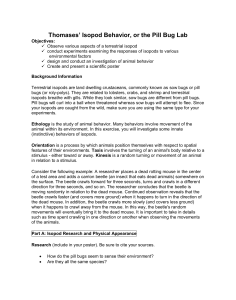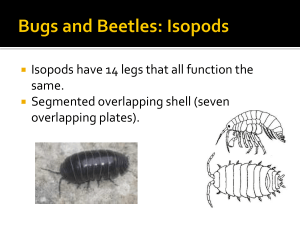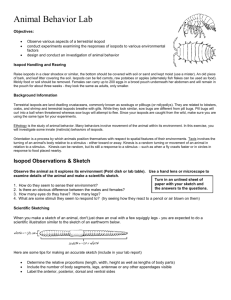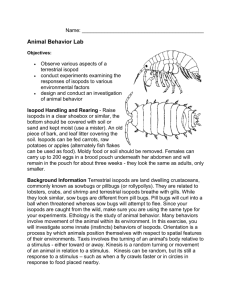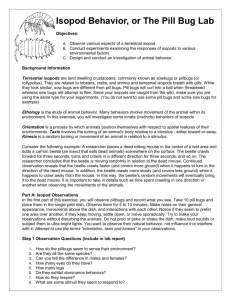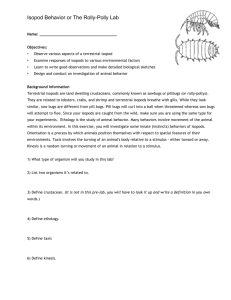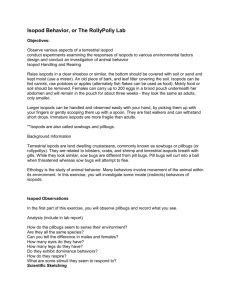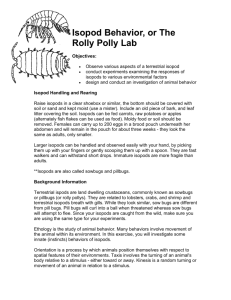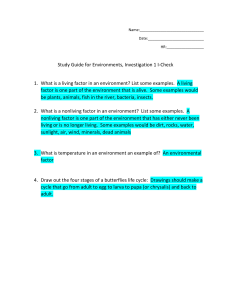Observing Behaviors: Pill bug Behavior
advertisement
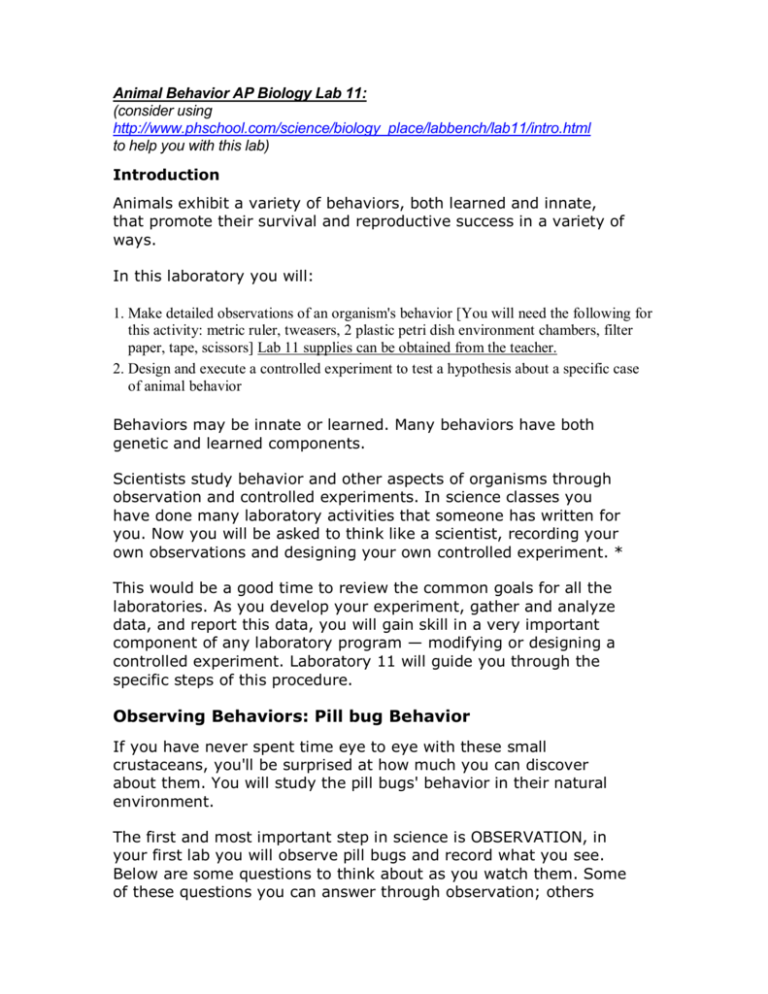
Animal Behavior AP Biology Lab 11: (consider using http://www.phschool.com/science/biology_place/labbench/lab11/intro.html to help you with this lab) Introduction Animals exhibit a variety of behaviors, both learned and innate, that promote their survival and reproductive success in a variety of ways. In this laboratory you will: 1. Make detailed observations of an organism's behavior [You will need the following for this activity: metric ruler, tweasers, 2 plastic petri dish environment chambers, filter paper, tape, scissors] Lab 11 supplies can be obtained from the teacher. 2. Design and execute a controlled experiment to test a hypothesis about a specific case of animal behavior Behaviors may be innate or learned. Many behaviors have both genetic and learned components. Scientists study behavior and other aspects of organisms through observation and controlled experiments. In science classes you have done many laboratory activities that someone has written for you. Now you will be asked to think like a scientist, recording your own observations and designing your own controlled experiment. * This would be a good time to review the common goals for all the laboratories. As you develop your experiment, gather and analyze data, and report this data, you will gain skill in a very important component of any laboratory program — modifying or designing a controlled experiment. Laboratory 11 will guide you through the specific steps of this procedure. Observing Behaviors: Pill bug Behavior If you have never spent time eye to eye with these small crustaceans, you'll be surprised at how much you can discover about them. You will study the pill bugs' behavior in their natural environment. The first and most important step in science is OBSERVATION, in your first lab you will observe pill bugs and record what you see. Below are some questions to think about as you watch them. Some of these questions you can answer through observation; others require you to read about pill bugs and crustaceans or think about what you already know. • What type of environment do pill bugs prefer in nature? • When are pill bugs the most active? Least active? • What do pill bugs eat? How do they get their food? When do they eat? • How do the pill bugs seem to sense their environment? • Are they all the same species? • Can you tell differences in males and females? • How many eyes do they have? • How many legs? • Do they exhibit any dominance behaviors? • How do they respire? • How do they grow? • What are some stimuli they seem to respond to? One way to record your observations of an organism is to make a sketch of it. In the next section we discuss how to do a scientific sketch. Scientific Sketching When you make a sketch of a pill bug, don't just draw an oval with a few squiggly legs — you are expected to do a scientific illustration similar to the sketch of an earthworm below. You will need to draw your organism from various angles in order to record all the details. Here are some tips for making an accurate sketch of your pill bug: 1. Determine the relative proportions: a. width : length; b. height : length; c. distance between eyes : width of body; d. length of antennae : length of body. 2. Count the number of body segments. 3. Count the number of legs. 4. Locate the eyes. 5. Label the body parts. 6. Note the size of the pill bug. STUDENT GUIDE LABORATORY LABORATORY 11 11. ANIMAL BEHAVIOR Objectives In this laboratory, you will • observe various aspects of the behavior of a terrestrial isopod • conduct experiments examining the responses of isopods to various environmental factors • design and conduct an investigation of animal behavior • hypothesize as to the reasons for the behaviors you observe Required Knowledge Before beginning this laboratory, you should understand • the concept of distribution of organisms in a resource gradient • the difference between kinesis and taxis Expectations At the completion of this laboratory, you should be able to • describe some aspects of animal behavior, such as orientation behavior • understand that behaviors are adaptations of an animal to its environment Background Isopods: Pill bugs and Sow bugs (Armadillidium vulgare; Porcellio laevis) Armadillidium vulgare; Porcellio laevis Terrestrial isopods are land dwelling crustaceans, commonly known as sow bugs or pill bugs. They have many other common names: potato bugs, wood lice (no relation to body lice), and roly-poly are just a few. Related to lobsters, crabs, and shrimp, terrestrial isopods breathe with gills. Although similar in size, color, and life cycle, pill bugs and sow bugs are different. When threatened, pill bugs can curl up into a tight ball for protection, while sow bugs either attempt to flee or remain perfectly still, appearing to be dead. Ethology is the study of animal behavior. Many behaviors involve movement of the animal within its environment. In this exercise you will investigate some innate (inherited, as opposed to learned) behaviors of isopods. Orientation is the process by which animals position themselves with respect to spatial features of their environments. Taxis involves the turning of an animal’s body relative to a stimulus. The animal may turn away from, toward, perpendicular to (etc.), the stimulus. The turning may or may not be followed by a corresponding movement of the animal in relation to the stimulus. Kinesis is random turning or movement of an animal in relation to a stimulus. Consider the following experiment: a researcher places a dead, rotting mouse in the center of a test surface of 1 m2. The researcher then places a carrion beetle (an insect that eats dead animal tissue) somewhere on the test surface and observes. The beetle crawls forward for three seconds, turns, and crawls in a different direction for three seconds, and so on. The researcher concludes that the beetle is moving randomly in relation to the dead mouse. Continued observation reveals that the beetle crawls faster (and covers more ground) when it happens to turn in the direction of the dead mouse. In addition, the beetle crawls more slowly (and covers less ground) when it happens to crawl away from the mouse. In this way, the beetle’s random movements will eventually bring it to the dead mouse, at which point other behavior patterns, such as feeding, will take over. 5 LABORATORY 11 STUDENT GUIDE Exercises 11A: General Observation of Isopod Behavior Procedure 1. Place a small amount of bedding into a petri dish or plastic cup. Use a sorting brush to transfer 5 isopods into the dish. Try to choose isopods of similar size. 2. Observe the isopods for 10 minutes. Make notes on their general appearance, movements, and interactions with each other. Note whether they seem to stay in one area, or if they move sporadically or continuously. Note any behaviors in which two or more isopods interact. Make observations without disturbing the animals in any way. Do not move the dish, make loud noises, or subject the animals to bright light. The goal is to observe their behavior while influencing it as little as possible. Record your observations below. –––––––––––––––––––––––––––––––––––––––––––––––––––––––––––––––––––– –––––––––––––––––––––––––––––––––––––––––––––––––––––––––––––––––––– –––––––––––––––––––––––––––––––––––––––––––––––––––––––––––––––––––– –––––––––––––––––––––––––––––––––––––––––––––––––––––––––––––––––––– –––––––––––––––––––––––––––––––––––––––––––––––––––––––––––––––––––– –––––––––––––––––––––––––––––––––––––––––––––––––––––––––––––––––––– 3. In the space provided below, make a detailed sketch of an isopod. Label your drawing. 6 STUDENT GUIDE LABORATORY 11 Exercises 11B: Orientation in Isopods Procedure 1. Place clean filter paper into each side of your Choice Chamber. 2. Using a dropping pipet, saturate the filter paper on one side of the chamber. Pour off any excess water so that it cannot run into the other side of the chamber and moisten the paper there. 3. Use a sorting brush to transfer five (5) isopods to each side of the chamber. Put on the lids. 4. Count and record, in Table 11.1, the number of animals on each side of the chamber every 30 seconds for 10 minutes. Continue to record, even if the isopods all move to one side or stop moving at all. Table 11.1 Orientation in Isopods Time (min:sec) # in Wet Chamber # in Dry Chamber Other Notes 0:00 0:30 1:00 1:30 2:00 2:30 3:00 3:30 4:00 4:30 5:00 5:30 6:00 6:30 7:00 7:30 8:00 8:30 9:00 9:30 10:00 7 LABORATORY 11 STUDENT GUIDE 5. Return your isopods to the stock culture or separate holding area. 6. Generate Graph 11.1 using two sets of data: the number of isopods on the wet side of the chamber and the number of isopods on the dry side of the chamber over time. For the graph, determine the following: a. The independent variable is _______________________________________. (Use to label the horizontal x-axis.) b. The dependent variable is _________________________________________. (Use to label the vertical y-axis.) Graph 11.1 Title: Label (y-axis): Label (x-axis): 8 STUDENT GUIDE Questions LABORATORY 11 1. Based upon your observations, do isopods orient with respect to moisture in the environment? Explain your answer. –––––––––––––––––––––––––––––––––––––––––––––––––––––––––––––––––––– –––––––––––––––––––––––––––––––––––––––––––––––––––––––––––––––––––– –––––––––––––––––––––––––––––––––––––––––––––––––––––––––––––––––––– –––––––––––––––––––––––––––––––––––––––––––––––––––––––––––––––––––– –––––––––––––––––––––––––––––––––––––––––––––––––––––––––––––––––––– –––––––––––––––––––––––––––––––––––––––––––––––––––––––––––––––––––– 2. If you answered “yes” to Question 1 above, was the orientation achieved through taxis or kinesis? Support your answer. –––––––––––––––––––––––––––––––––––––––––––––––––––––––––––––––––––– –––––––––––––––––––––––––––––––––––––––––––––––––––––––––––––––––––– –––––––––––––––––––––––––––––––––––––––––––––––––––––––––––––––––––– –––––––––––––––––––––––––––––––––––––––––––––––––––––––––––––––––––– –––––––––––––––––––––––––––––––––––––––––––––––––––––––––––––––––––– –––––––––––––––––––––––––––––––––––––––––––––––––––––––––––––––––––– 3. How might this behavior be advantageous to isopods? –––––––––––––––––––––––––––––––––––––––––––––––––––––––––––––––––––– –––––––––––––––––––––––––––––––––––––––––––––––––––––––––––––––––––– –––––––––––––––––––––––––––––––––––––––––––––––––––––––––––––––––––– –––––––––––––––––––––––––––––––––––––––––––––––––––––––––––––––––––– –––––––––––––––––––––––––––––––––––––––––––––––––––––––––––––––––––– –––––––––––––––––––––––––––––––––––––––––––––––––––––––––––––––––––– Exercises 11C: Student-Designed Experiments on Isopod Behavior Procedure • Select one factor listed below to investigate. Factor Conditions temperature cool vs. warm light light vs. dark, or light vs. shade pH low pH vs. high pH substrate (surface) smooth vs. rough • Your teacher will now point out the materials available for conducting your investigation. In designing your experiment, be careful not to injure the isopods. Lamps placed too close to the organisms, for example, may generate dangerous heat. 9 LABORATORY 11 STUDENT GUIDE 1. State the factor to be tested: ___________________________________________ –––––––––––––––––––––––––––––––––––––––––––––––––––––––––––––––––––– 2. Based on laboratory experience with isopods, state the hypothesis to be explored: –––––––––––––––––––––––––––––––––––––––––––––––––––––––––––––––––––– –––––––––––––––––––––––––––––––––––––––––––––––––––––––––––––––––––– –––––––––––––––––––––––––––––––––––––––––––––––––––––––––––––––––––– –––––––––––––––––––––––––––––––––––––––––––––––––––––––––––––––––––– –––––––––––––––––––––––––––––––––––––––––––––––––––––––––––––––––––– –––––––––––––––––––––––––––––––––––––––––––––––––––––––––––––––––––– –––––––––––––––––––––––––––––––––––––––––––––––––––––––––––––––––––– 3. List the materials used in the experiment: –––––––––––––––––––––––––––––––––––––––––––––––––––––––––––––––––––– –––––––––––––––––––––––––––––––––––––––––––––––––––––––––––––––––––– –––––––––––––––––––––––––––––––––––––––––––––––––––––––––––––––––––– –––––––––––––––––––––––––––––––––––––––––––––––––––––––––––––––––––– –––––––––––––––––––––––––––––––––––––––––––––––––––––––––––––––––––– –––––––––––––––––––––––––––––––––––––––––––––––––––––––––––––––––––– –––––––––––––––––––––––––––––––––––––––––––––––––––––––––––––––––––– 4. List the procedure to be followed (step-by-step): –––––––––––––––––––––––––––––––––––––––––––––––––––––––––––––––––––– –––––––––––––––––––––––––––––––––––––––––––––––––––––––––––––––––––– –––––––––––––––––––––––––––––––––––––––––––––––––––––––––––––––––––– –––––––––––––––––––––––––––––––––––––––––––––––––––––––––––––––––––– –––––––––––––––––––––––––––––––––––––––––––––––––––––––––––––––––––– –––––––––––––––––––––––––––––––––––––––––––––––––––––––––––––––––––– –––––––––––––––––––––––––––––––––––––––––––––––––––––––––––––––––––– 5. Describe the data that will be collected and how the results will be displayed. (Use Graph 11.2, on page 12, if appropriate.) –––––––––––––––––––––––––––––––––––––––––––––––––––––––––––––––––––– –––––––––––––––––––––––––––––––––––––––––––––––––––––––––––––––––––– –––––––––––––––––––––––––––––––––––––––––––––––––––––––––––––––––––– –––––––––––––––––––––––––––––––––––––––––––––––––––––––––––––––––––– –––––––––––––––––––––––––––––––––––––––––––––––––––––––––––––––––––– –––––––––––––––––––––––––––––––––––––––––––––––––––––––––––––––––––– –––––––––––––––––––––––––––––––––––––––––––––––––––––––––––––––––––– 6. Perform the experiment. 7. Return the isopods to the stock culture. 10 STUDENT GUIDE LABORATORY 11 8. State your conclusions concerning the hypothesis tested. –––––––––––––––––––––––––––––––––––––––––––––––––––––––––––––––––––– –––––––––––––––––––––––––––––––––––––––––––––––––––––––––––––––––––– –––––––––––––––––––––––––––––––––––––––––––––––––––––––––––––––––––– –––––––––––––––––––––––––––––––––––––––––––––––––––––––––––––––––––– –––––––––––––––––––––––––––––––––––––––––––––––––––––––––––––––––––– –––––––––––––––––––––––––––––––––––––––––––––––––––––––––––––––––––– –––––––––––––––––––––––––––––––––––––––––––––––––––––––––––––––––––– 9. Obtain results from all groups in your class for both the kinesis experiment and the designed experiments. Graph 11.2 Title: Label (y-axis): Label (x-axis): 11 LABORATORY 11 Questions STUDENT GUIDE 1. Considering all of the factors tested by your class, what type of environment do isopods seem to prefer? –––––––––––––––––––––––––––––––––––––––––––––––––––––––––––––––––––– –––––––––––––––––––––––––––––––––––––––––––––––––––––––––––––––––––– –––––––––––––––––––––––––––––––––––––––––––––––––––––––––––––––––––– –––––––––––––––––––––––––––––––––––––––––––––––––––––––––––––––––––– –––––––––––––––––––––––––––––––––––––––––––––––––––––––––––––––––––– –––––––––––––––––––––––––––––––––––––––––––––––––––––––––––––––––––– 2. How do you think isopods locate appropriate environments? –––––––––––––––––––––––––––––––––––––––––––––––––––––––––––––––––––– –––––––––––––––––––––––––––––––––––––––––––––––––––––––––––––––––––– –––––––––––––––––––––––––––––––––––––––––––––––––––––––––––––––––––– –––––––––––––––––––––––––––––––––––––––––––––––––––––––––––––––––––– –––––––––––––––––––––––––––––––––––––––––––––––––––––––––––––––––––– –––––––––––––––––––––––––––––––––––––––––––––––––––––––––––––––––––– 3. If you suddenly turned a rock over and found isopods under it, what would you expect them to be doing? If you watched the isopods for a few minutes, how would you expect to see their behavior change? –––––––––––––––––––––––––––––––––––––––––––––––––––––––––––––––––––– –––––––––––––––––––––––––––––––––––––––––––––––––––––––––––––––––––– –––––––––––––––––––––––––––––––––––––––––––––––––––––––––––––––––––– –––––––––––––––––––––––––––––––––––––––––––––––––––––––––––––––––––– –––––––––––––––––––––––––––––––––––––––––––––––––––––––––––––––––––– –––––––––––––––––––––––––––––––––––––––––––––––––––––––––––––––––––– 12
